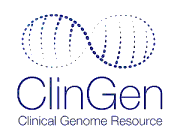The ClinGen Evidence Repository is an FDA-recognized human genetic variant database containing expert-curated assertions regarding variants' pathogenicity and supporting evidence summaries.
[Disclaimer]
- See Evidence submitted by expert panel for details.
- Curation Version - 1.0
- Curation History
- JSON LD for Version 1.0
CA291224645
Gene: ITGB3
Condition: Glanzmann's thrombasthenia
Inheritance Mode: Autosomal recessive inheritance
UUID: 862523d6-6c86-4068-aecb-c9e5446d8fb8
Approved on: 2021-04-20
Published on: 2021-08-20
HGVS expressions
NM_000212.3:c.431T>G
NC_000017.11:g.47284512T>G
CM000679.2:g.47284512T>G
NC_000017.10:g.45361878T>G
CM000679.1:g.45361878T>G
NC_000017.9:g.42716877T>G
NG_008332.2:g.35671T>G
ENST00000559488.7:c.431T>G
ENST00000559488.5:c.431T>G
ENST00000560629.1:n.396T>G
ENST00000571680.1:c.431T>G
NM_000212.2:c.431T>G
Evidence submitted by expert panel
The information on this website is not intended for direct diagnostic use or medical decision-making without review by a genetics professional. Individuals should not change their health behavior solely on the basis of information contained on this website. If you have questions about the information contained on this website, please see a health care professional.
